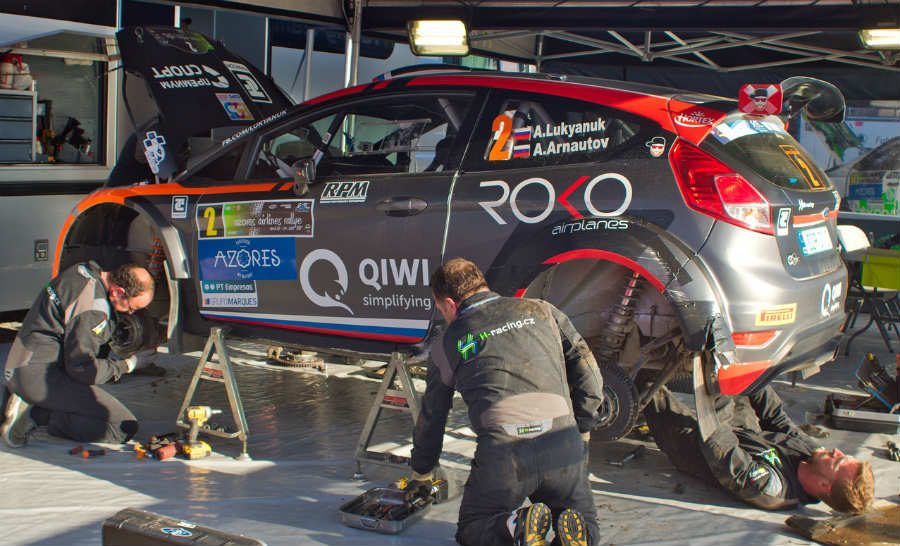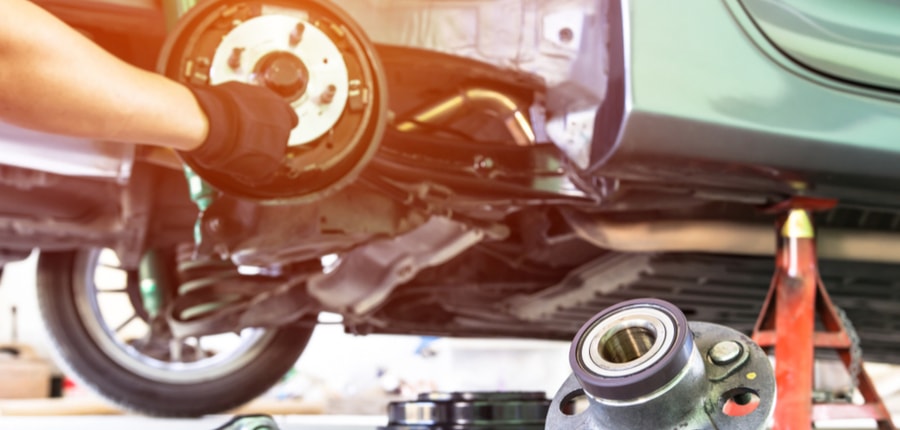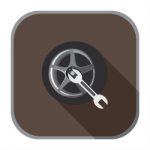Most bearing failures are the result of simple wear. Ideally, if the manufacturing tolerances were good and the seals effective, wear is minimal and very slow.
Excess wear on the bearings can occur if a vehicle is overloaded; causing the bearings to run hot and break down their lubricant – leading to more rapid wear. Seals can also fail; allowing lubricant to escape and grit and moisture to enter which will cause premature wear.
Impacts can also cause minor problems in the bearing tolerances or flaws in the races which can lead to bearing failure. Many vehicle manufacturers recommend that anytime a collision leads to a bent part, the bearings on that corner should be replaced.
The Cost of Replacing a Wheel Bearing
A few examples of possible wheel bearing replacement costs on some common vehicles using $100 per hour labor rate are as follows:
- On a 2007 Chevrolet 1500 with four-wheel drive, the labor time for the front hub assembly replacement is 1 hour and the AC Delco replacement part is about $251. This would make the replacement of one front hub assembly about $351. On the rear, the vehicle uses axle bearings.
- On a 2004 Camry with the 3-liter engine, the labor time for wheel bearing replacement is 2.4 hours on the front (a press-in cartridge bearing) and 1.6 hours for the rear hub assembly. The front bearing costs about $33 for a Beck/Arnley replacement part and a rear hub assembly costs about $102 for an SKF part. That would make the job about $273 for a front wheel bearing replacement and about $262 for the rear.
- On a 2008 Ford Fusion with front-wheel drive and the 3.0-liter engine, the labor time for replacing the front cartridge bearing is 1.6 hours and for the rear hub assembly, it’s .9 hours. An aftermarket National bearing for the front is about $35 versus about $61 for an OE replacement bearing through dealer sources. A rear hub assembly costs about $67 for a Moog part or about $188 for an OE part. This would make the job for a front wheel bearing replacement about $195 going with aftermarket parts or about $221 with OE parts. For the rear wheel bearing replacement, the job would come to about $157 with aftermarket parts or about $278 with OE parts.
- On a 2007 BMW 328i with a 3-liter engine, the labor time for replacing a front hub assembly is 1.1 hours and for a rear hub assembly, it’s 1.9 hours. An aftermarket Timken front hub assembly costs about $162 and the OE BMW part costs about $315. An aftermarket Timken rear hub assembly costs about $54 and an OE BMW part costs about $99. This makes the job about $272 for one front wheel bearing replacement with aftermarket parts and $425 if done with factory parts. On the rear, costs are about $244 for a rear hub assembly replacement or $289 if done with OE parts.
Labor time for wheel bearing replacement isn’t necessarily charged at book rate – some shops use a flat fee for common hub assembly replacements. And parts prices vary widely as well.
It’s also worth mentioning that, for most common makes, vehicle manufacturers typically don’t manufacture bearings; they outsource to larger bearing manufacturers. OE bearings come from various sources, and choosing a name-brand part from a large bearing manufacturer for a repair is often as safe and reliable a choice as going with an OE branded part.
Kinds of Wheel Bearing
There are three main kinds of wheel bearing. The old-style wheel bearing is two-piece; including a tapered roller bearing and the race that the bearings roll against. On each wheel, there would be two bearings and two races – inners and outers.
When most cars were rear-wheel drive, each front wheel used a pair of each of these installed in the front rotor. It was normal maintenance during brake service to clean and repack the wheel bearings and replace the seal that held the grease in and protected the bearings from dirt and moisture.
This kind of wheel bearing is seldom seen on modern cars anymore, but can still be found on the front of some 2WD trucks, older 4WD trucks, and sometimes, on the rear of FWD vehicles.
Another type, which is still very common, is the cartridge bearing. This is a one-piece assembly that incorporates an inner and an out bearing and races, as well as seals. These have the disadvantage of being non-serviceable, but are built more precisely and sealed better, and so, are very long-lasting.
The third type, a hub/bearing assembly, is most common. This is a bolt-on assembly; essentially a cartridge bearing pressed into a cast housing with a hub flange that bolts onto the steering knuckle on the front of a vehicle or bolts to the knuckle or axle at the rear of a vehicle.
Its main advantages are being fully pre-assembled and tested, as well as incorporating an ABS tone-ring and sensor (where applicable); pre-adjusted and protected in a sealed assembly.
Where this bearing is used on a drive axle, the axle splines into the center of the bearing flange and is fixed with a nut. There is often no center hole or nut when used on a non-drive wheel.
Cartridge bearings and hub assemblies are usually reliable, permanently lubricated, and have no scheduled service interval.
On some vehicles with a solid rear axle, there is a bearing either pressed on to the rear axle shaft or pressed into the rear axle tube. Typically, these are considered “axle bearings” rather than wheel bearings.
On the heavier rear axles used on ¾ ton and 1-ton trucks, sometimes, there may be inner and outer tapered roller bearings in a hub that runs off a spindle-end of the axle on each side. This is still considered a wheel bearing.

What is Involved in Wheel Bearing Replacement
Inspecting or replacing tapered roller bearings is fairly simple; brake calipers are removed, the nut that sets the bearing preload is removed from the spindle, and the rotor or hub housing then slides from the spindle. The grease seal is removed from the back.
Bearings can be taken out and inspected or replaced at that point. If a bearing is replaced, its race is replaced also. This is driven out of the hub and a new one tapped in.
On a 4WD vehicle with this set-up on the front axle, there is the additional step of disassembling the 4WD locking mechanism. On the rear axle of a heavier truck, there is the additional step of unbolting and removing the driving axle from the hub before the preload nut can be accessed.
On the second style of wheel bearing – the cartridge bearing – replacement involves removing the steering knuckle or rear knuckle from the vehicle and doing the work on a press. The hub flange is driven out, holding clips and external seals are removed, the old cartridge pressed out, and a new one pressed in. Seals are installed, then, the hub flange is pressed back into place.
On the third type – the bolt-on hub assembly; what is necessary is to remove the brake and rotor assembly, remove the center nut (if applicable; that sets the bearing preload on a drive-wheel type hub assembly), and then, remove the three or four bolts that hold the assembly to the knuckle. If there is an ABS sensor involved, that is also removed.
Other Factors Why Wheel Bearings Fail
Apart from those previously mentioned, there can be a plethora of other factors for wheel bearings failure, and the cost to replace wheel bearings can also vary based on these. On the old-style tapered roller bearings, failures can come from the bearing preload being set too tight or too loose; leading (respectively) to overheating or to excess play and internal wear and sometimes, seal failure. That style has the advantage in a way that it can be taken apart and inspected and assessed fairly easily.
Cartridge bearings can fail in the same ways. Bearing preload is often set by an axle nut on the shaft that splines into the hub which is pressed through the bearing. Manufacturers provide torque specs for the axle nut and under-torquing or over-torquing this can lead to failures.
The first main sign of a bearing problem is usually noise that varies with road speed. Among all the road and engine noises that a car produces, it’s not always easy to distinguish bearing noise.
One trick is to know that each bearing assembly has an inner and an outer race and these are loaded and unloaded depending on the direction a vehicle is steered. On a road test, steering one way and then the other – if the noise gets better and then worse (or vice versa) – then, it’s probably a wheel bearing.
Sometimes, bearings fail and don’t make any notable noise. With a vehicle up in the air checking for play in the bearings is a normal thing in routine service and safety inspections.
The older style of tapered roller bearing is allowed some small amount of play and looseness while a cartridge bearing or hub assembly should exhibit essentially zero play. If a bearing of those styles has a detectable play, it should be replaced.
Another method is to run a vehicle in gear while up on a lift and listen to the bearings with a mechanic’s stethoscope. This is a common method of confirming a diagnosis as other things (differentials and transmissions) have internal bearings that can make nearly identical noises which are often hard to pinpoint or rule out on a road test.
Other Related Problems
To access a wheel bearing, the wheel and brakes are removed. Any brake or tire problems are most economically taken care of while they are already off.
When replacing a cartridge bearing that presses into a knuckle, it’s not uncommon to find that the new bearing doesn’t press into the knuckle tightly. That can be caused by collision damage or by distress to the machined surface during the pressing operation or it could be from corrosion issues.
However, if the bearing won’t install as a tight press-fit without play, the knuckle should be replaced. Unfortunately, that’s often something that isn’t known until the work is well underway and parts are often hard to source.

Another issue with cartridge bearing installation can be the hub flange; the flange that carries the studs that hold the wheel on and extends into the bearing. The end of this extension into the bearing is a flat machined surface that bears against the CV axle (on most vehicles) and determines bearing preload when the axle nut is torqued.
If this machined end is visibly damaged or worn as can happen when a worn bearing allows play and movement, then, the hub flange should be replaced. These are often available with the bearing as a kit and are a common enough issue that availability usually isn’t bad.
One general rule in automotive repair is that when any suspension part between the wheels is replaced, the wheel alignment should be checked. That’s not strictly necessary with a wheel bearing replacement, but it’s a common recommendation and not a bad idea. Especially if a shop offers free alignment checks, a little bit of extra time taken is worthwhile.

